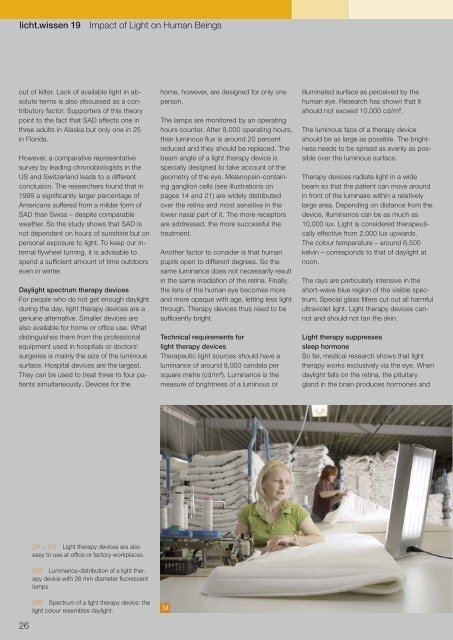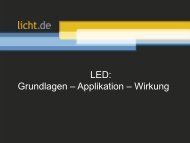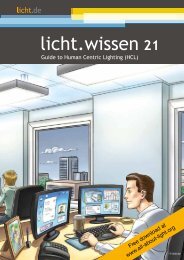licht.wissen 19 No. "Impact of Light on Human Beings"
Light synchronises our “internal clock”. Lighting that copies daylight has more than just a visual impact; it supports bodily functions 24 hours a day. Booklet 19 is intended for all those who want to delve into the topic of Impact of Light on Human Beings. The 56 pages helps to get an overview of what melanopic light can effect. Free Download at www.licht.de/en
Light synchronises our “internal clock”. Lighting that copies daylight has more than just a visual impact; it supports bodily functions 24 hours a day. Booklet 19 is intended for all those who want to delve into the topic of Impact of Light on Human Beings. The 56 pages helps to get an overview of what melanopic light can effect. Free Download at www.licht.de/en
Create successful ePaper yourself
Turn your PDF publications into a flip-book with our unique Google optimized e-Paper software.
<str<strong>on</strong>g>licht</str<strong>on</strong>g>.<str<strong>on</strong>g>wissen</str<strong>on</strong>g> <str<strong>on</strong>g>19</str<strong>on</strong>g><br />
<str<strong>on</strong>g>Impact</str<strong>on</strong>g> <str<strong>on</strong>g>of</str<strong>on</strong>g> <str<strong>on</strong>g>Light</str<strong>on</strong>g> <strong>on</strong> <strong>Human</strong> Beings<br />
out <str<strong>on</strong>g>of</str<strong>on</strong>g> kilter. Lack <str<strong>on</strong>g>of</str<strong>on</strong>g> available light in absolute<br />
terms is also discussed as a c<strong>on</strong>tributory<br />
factor. Supporters <str<strong>on</strong>g>of</str<strong>on</strong>g> this theory<br />
point to the fact that SAD affects <strong>on</strong>e in<br />
three adults in Alaska but <strong>on</strong>ly <strong>on</strong>e in 25<br />
in Florida.<br />
However, a comparative representative<br />
survey by leading chr<strong>on</strong>obiologists in the<br />
US and Switzerland leads to a different<br />
c<strong>on</strong>clusi<strong>on</strong>. The researchers found that in<br />
<str<strong>on</strong>g>19</str<strong>on</strong>g>99 a significantly larger percentage <str<strong>on</strong>g>of</str<strong>on</strong>g><br />
Americans suffered from a milder form <str<strong>on</strong>g>of</str<strong>on</strong>g><br />
SAD than Swiss – despite comparable<br />
weather. So the study shows that SAD is<br />
not dependent <strong>on</strong> hours <str<strong>on</strong>g>of</str<strong>on</strong>g> sunshine but <strong>on</strong><br />
pers<strong>on</strong>al exposure to light. To keep our internal<br />
flywheel turning, it is advisable to<br />
spend a sufficient amount <str<strong>on</strong>g>of</str<strong>on</strong>g> time outdoors<br />
even in winter.<br />
Daylight spectrum therapy devices<br />
For people who do not get enough daylight<br />
during the day, light therapy devices are a<br />
genuine alternative. Smaller devices are<br />
also available for home or <str<strong>on</strong>g>of</str<strong>on</strong>g>fice use. What<br />
distinguishes them from the pr<str<strong>on</strong>g>of</str<strong>on</strong>g>essi<strong>on</strong>al<br />
equipment used in hospitals or doctors’<br />
surgeries is mainly the size <str<strong>on</strong>g>of</str<strong>on</strong>g> the luminous<br />
surface. Hospital devices are the largest.<br />
They can be used to treat three to four patients<br />
simultaneously. Devices for the<br />
home, however, are designed for <strong>on</strong>ly <strong>on</strong>e<br />
pers<strong>on</strong>.<br />
The lamps are m<strong>on</strong>itored by an operating<br />
hours counter. After 8,000 operating hours,<br />
their luminous flux is around 20 percent<br />
reduced and they should be replaced. The<br />
beam angle <str<strong>on</strong>g>of</str<strong>on</strong>g> a light therapy device is<br />
specially designed to take account <str<strong>on</strong>g>of</str<strong>on</strong>g> the<br />
geometry <str<strong>on</strong>g>of</str<strong>on</strong>g> the eye. Melanopsin-c<strong>on</strong>taining<br />
gangli<strong>on</strong> cells (see illustrati<strong>on</strong>s <strong>on</strong><br />
pages 14 and 21) are widely distributed<br />
over the retina and most sensitive in the<br />
lower nasal part <str<strong>on</strong>g>of</str<strong>on</strong>g> it. The more receptors<br />
are addressed, the more successful the<br />
treatment.<br />
Another factor to c<strong>on</strong>sider is that human<br />
pupils open to different degrees. So the<br />
same luminance does not necessarily result<br />
in the same irradiati<strong>on</strong> <str<strong>on</strong>g>of</str<strong>on</strong>g> the retina. Finally,<br />
the lens <str<strong>on</strong>g>of</str<strong>on</strong>g> the human eye becomes more<br />
and more opaque with age, letting less light<br />
through. Therapy devices thus need to be<br />
sufficiently bright.<br />
Technical requirements for<br />
light therapy devices<br />
Therapeutic light sources should have a<br />
luminance <str<strong>on</strong>g>of</str<strong>on</strong>g> around 8,000 candela per<br />
square metre (cd/m 2 ). Luminance is the<br />
measure <str<strong>on</strong>g>of</str<strong>on</strong>g> brightness <str<strong>on</strong>g>of</str<strong>on</strong>g> a luminous or<br />
illuminated surface as perceived by the<br />
human eye. Research has shown that it<br />
should not exceed 10,000 cd/m 2 .<br />
The luminous face <str<strong>on</strong>g>of</str<strong>on</strong>g> a therapy device<br />
should be as large as possible. The brightness<br />
needs to be spread as evenly as possible<br />
over the luminous surface.<br />
Therapy devices radiate light in a wide<br />
beam so that the patient can move around<br />
in fr<strong>on</strong>t <str<strong>on</strong>g>of</str<strong>on</strong>g> the luminaire within a relatively<br />
large area. Depending <strong>on</strong> distance from the<br />
device, illuminance can be as much as<br />
10,000 lux. <str<strong>on</strong>g>Light</str<strong>on</strong>g> is c<strong>on</strong>sidered therapeutically<br />
effective from 2,000 lux upwards.<br />
The colour temperature – around 6,500<br />
kelvin – corresp<strong>on</strong>ds to that <str<strong>on</strong>g>of</str<strong>on</strong>g> daylight at<br />
no<strong>on</strong>.<br />
The rays are particularly intensive in the<br />
short-wave blue regi<strong>on</strong> <str<strong>on</strong>g>of</str<strong>on</strong>g> the visible spectrum.<br />
Special glass filters cut out all harmful<br />
ultraviolet light. <str<strong>on</strong>g>Light</str<strong>on</strong>g> therapy devices cannot<br />
and should not tan the skin.<br />
<str<strong>on</strong>g>Light</str<strong>on</strong>g> therapy suppresses<br />
sleep horm<strong>on</strong>e<br />
So far, medical research shows that light<br />
therapy works exclusively via the eye. When<br />
daylight falls <strong>on</strong> the retina, the pituitary<br />
gland in the brain produces horm<strong>on</strong>es and<br />
[34 + 37] <str<strong>on</strong>g>Light</str<strong>on</strong>g> therapy devices are also<br />
easy to use at <str<strong>on</strong>g>of</str<strong>on</strong>g>fice or factory workplaces.<br />
[35] Luminance distributi<strong>on</strong> <str<strong>on</strong>g>of</str<strong>on</strong>g> a light therapy<br />
device with 26 mm diameter fluorescent<br />
lamps<br />
[36] Spectrum <str<strong>on</strong>g>of</str<strong>on</strong>g> a light therapy device: the<br />
light colour resembles daylight. 34<br />
26

















